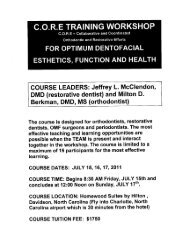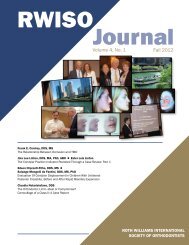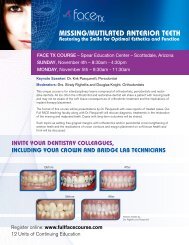2010 RWISO Journal - Roth Williams International Society of ...
2010 RWISO Journal - Roth Williams International Society of ...
2010 RWISO Journal - Roth Williams International Society of ...
Create successful ePaper yourself
Turn your PDF publications into a flip-book with our unique Google optimized e-Paper software.
idge determines the width <strong>of</strong> the mandible. According to<br />
Andrews’ definition, the WALA ridge is coincident with the<br />
most prominent portion <strong>of</strong> the buccal alveolar bone when<br />
viewed from the occlusal surface (Figure 11).<br />
Figure 11 Demarcation <strong>of</strong> the WALA ridge.<br />
The WALA ridge is essentially coincident with the<br />
mucogingival junction and approximates the center <strong>of</strong> resistance<br />
<strong>of</strong> the mandibular molars. In a mature patient,<br />
the WALA ridge and the width <strong>of</strong> the mandible cannot be<br />
modified with conventional treatment. Thus the WALA ridge<br />
forms a stable basis for the Element III analysis. 6<br />
The Element III analysis is based on the width change,<br />
if any, <strong>of</strong> the maxilla needed to have upper and lower posterior<br />
teeth upright in bone, centered in bone, and properly<br />
intercuspated. To determine the discrepancy, the first step is<br />
to determine the width <strong>of</strong> the mandible, or the horizontal<br />
distance from the WALA ridge on the right side to the WALA<br />
ridge on the left side. According to Andrews, optimally positioned<br />
mandibular molars will be upright in the alveolus,<br />
and their facial axis (FA) point, or center <strong>of</strong> the crown, will<br />
be horizontally positioned 2 mm from the WALA ridge. With<br />
this information, the width <strong>of</strong> the mandible is then defined as<br />
the WALA-WALA distance minus 4 mm. 6<br />
Figure 12 Determination <strong>of</strong> mandibular<br />
WALA-WALA and FA-FA distances.<br />
The width <strong>of</strong> the maxilla is based on optimization <strong>of</strong> the<br />
angulation <strong>of</strong> the maxillary molars. To determine this width,<br />
one measures the horizontal distance from the FA point <strong>of</strong><br />
the left molar to the FA point <strong>of</strong> the right molar and records<br />
the measurement.<br />
Figure 13 Determining maxillary FA-FA distance and<br />
estimating the change in maxillary molar inclination.<br />
One then looks at the angulation <strong>of</strong> the maxillary molars<br />
and estimates the amount <strong>of</strong> horizontal change that will<br />
occur between the FA points <strong>of</strong> the right and left molars<br />
when they are optimally angulated. The estimated amount <strong>of</strong><br />
change is subtracted from the original FA-FA measurement.<br />
The result represents the width <strong>of</strong> the maxilla. 6<br />
In order to have optimally positioned and optimally inclined<br />
molar teeth that intercuspate well, Andrews states that<br />
the maxillary width must be 5 mm greater than the mandibular<br />
width. 6 In order to determine the amount <strong>of</strong> transverse<br />
discrepancy, or Element III change, needed to produce an<br />
ideal result, one takes the optimal mandibular width, adds<br />
5 mm, and subtracts the maxillary width. An example <strong>of</strong> the<br />
entire analysis is shown in Figure 14.<br />
Figure 14 Example <strong>of</strong> Andrews’ Element III<br />
transverse analysis.<br />
<strong>RWISO</strong> <strong>Journal</strong> | September <strong>2010</strong><br />
15








